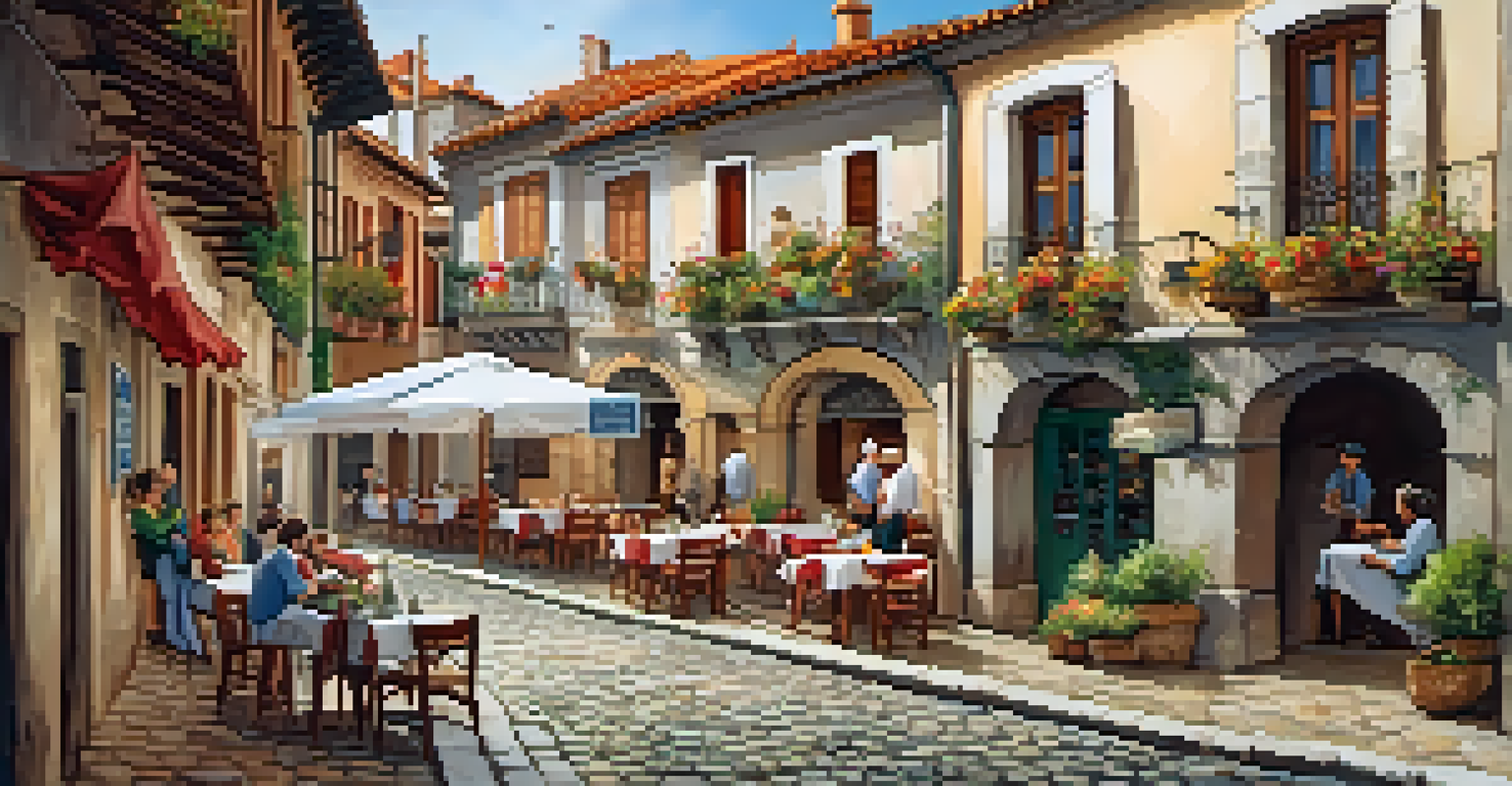The Pilgrimage to Santiago: A Journey Through Spanish Culture

Understanding the Camino de Santiago and Its Origins
The Camino de Santiago, or the Way of St. James, is a historic pilgrimage route leading to the shrine of St. James in Santiago de Compostela, Spain. Its roots can be traced back to the 9th century, when the remains of the apostle St. James were discovered in Galicia. This discovery sparked a wave of pilgrimages across Europe, with many believing that the journey would grant them spiritual benefits and forgiveness for their sins.
The journey of a thousand miles begins with one step.
Over the centuries, the pilgrimage has evolved into a symbol of faith, resilience, and cultural unity. Pilgrims from all walks of life embark on this journey, traversing diverse landscapes, from lush valleys to rugged mountains. Each route offers its own charm and challenges, inviting travelers to reflect on their personal journeys while immersing themselves in the rich history of the region.
Today, the Camino de Santiago continues to attract thousands of pilgrims annually, drawing attention not only for its spiritual significance but also for its cultural and historical merits. It serves as a reminder of the shared human experience, connecting people through their stories, struggles, and triumphs along the way.
The Routes: Exploring the Different Ways to Santiago
There are several routes to Santiago, each offering unique experiences and landscapes. The most popular, the Camino Francés, stretches approximately 800 kilometers from Saint-Jean-Pied-de-Port in France to Santiago. Along this route, pilgrims encounter charming villages, historic churches, and breathtaking vistas, making it a vibrant tapestry of Spanish culture.

Another notable route is the Camino Portugués, which begins in Portugal and winds its way through the picturesque landscapes of northern Spain. This path offers a different cultural perspective, with influences from Portugal visible in the cuisine and architecture. Pilgrims often find solace in the quieter paths, allowing for personal reflection and connection with nature.
Historic Roots of the Camino
The Camino de Santiago originated in the 9th century following the discovery of St. James' remains, inspiring countless pilgrimages across Europe.
For those seeking a more off-the-beaten-path experience, the Camino del Norte hugs the northern coastline of Spain, showcasing stunning ocean views and rugged cliffs. Each route presents an opportunity to engage with local traditions, taste regional delicacies, and forge connections with fellow travelers, enriching the overall pilgrimage experience.
Cultural Highlights Along the Camino Routes
As pilgrims traverse the Camino, they encounter a wealth of cultural treasures and historical landmarks that enrich their journey. One such highlight is the stunning Cathedral of Santiago de Compostela, an architectural marvel that serves as the pilgrimage's final destination. Its intricate façade and awe-inspiring interior draw visitors and pilgrims alike, creating a sense of wonder and reverence.
Travel not to escape life, but so life doesn’t escape you.
Along the way, travelers can explore diverse cultural gems, from the ancient Roman ruins in León to the vibrant street art in Bilbao. Each town and village has its own story, often reflected in local festivals, traditional music, and artisanal crafts. These cultural experiences foster a deeper appreciation for the region's heritage and its people.
Moreover, the culinary delights of Spain are an integral part of the pilgrimage experience. Pilgrims can savor regional specialties, such as the famous pulpo a la gallega (Galician octopus) or delicious pintxos in the Basque Country. Food becomes a shared experience, allowing travelers to bond over meals and create lasting memories.
The Spiritual Journey: Reflection and Growth
Beyond the physical journey, the pilgrimage to Santiago often serves as a profound spiritual experience for many. Pilgrims embark on the Camino seeking answers, healing, or a deeper connection with their faith. The rhythm of walking allows for introspection, prompting individuals to confront their thoughts, emotions, and beliefs.
As travelers navigate the challenges of the pilgrimage, they often find a sense of community among fellow pilgrims. Shared experiences, stories, and encouragement create bonds that transcend cultural differences. This sense of belonging fosters personal growth and resilience, transforming the journey into a holistic experience.
Diverse Routes Offer Unique Journeys
Various routes like the Camino Francés and Camino Portugués provide distinct landscapes and cultural experiences, enriching each pilgrim's journey.
Ultimately, the pilgrimage becomes a metaphor for life's journey, where every step represents a choice, an opportunity for growth, and a chance to connect with something greater. Many pilgrims return home with renewed perspectives, enriched by the lessons learned along the way.
Modern Pilgrimage: A Blend of Tradition and Contemporary Life
In recent years, the Camino de Santiago has seen a resurgence in popularity, attracting not only religious pilgrims but also adventure seekers and cultural enthusiasts. This modern pilgrimage embraces a blend of tradition and contemporary life, allowing people to engage with the route in ways that resonate with their personal beliefs and lifestyles.
Digital nomads, for example, often choose to walk the Camino while working remotely, finding inspiration in the landscapes and experiences along the way. This merging of work and pilgrimage allows for a unique exploration of Spanish culture while maintaining a modern lifestyle. It highlights the adaptability of the Camino to contemporary needs and aspirations.
However, the essence of the pilgrimage remains intact, as individuals continue to seek connection, purpose, and meaning. The Camino serves as a reminder that the journey itself is as significant as the destination, inviting all who walk its paths to reflect on their own stories and the world around them.
Sustainable Travel: Protecting the Camino Experience
As the popularity of the Camino de Santiago grows, so does the need for sustainable travel practices to protect this cherished experience. Pilgrims and travelers are becoming increasingly aware of their environmental impact and are seeking ways to minimize their footprint along the route. Simple actions, such as respecting nature and supporting local businesses, can make a significant difference.
Local organizations and communities are also taking steps to promote sustainable tourism, ensuring that the Camino remains accessible for future generations. Initiatives like waste reduction, conservation efforts, and responsible tourism campaigns aim to preserve the cultural and natural heritage of the region. By engaging with these initiatives, visitors can contribute to the ongoing legacy of the Camino.
Spiritual and Personal Growth
The pilgrimage fosters introspection and community, allowing travelers to connect deeply with themselves and others along the way.
Ultimately, sustainable travel is not just about protecting the environment; it's about fostering a respectful relationship with the cultures and communities along the way. By embracing responsible practices, pilgrims can fully experience the beauty of the Camino while leaving a positive impact on the places they visit.
Final Thoughts: The Timeless Allure of the Camino de Santiago
The pilgrimage to Santiago de Compostela is more than just a physical journey; it is a celebration of Spanish culture, history, and community. Each step taken along the Camino weaves together stories of hope, healing, and connection, creating a rich tapestry that resonates with pilgrims from around the world. Whether one walks for spiritual reasons, personal growth, or the sheer beauty of the landscapes, the Camino offers a unique experience that lingers long after the journey ends.
As travelers share their experiences, they contribute to the living history of the Camino, inspiring others to embark on their own adventures. The allure of the pilgrimage lies in its timelessness, where ancient traditions meet modern-day explorations. It serves as a reminder of the power of shared experiences and the beauty of human connection.

Ultimately, the Camino de Santiago invites everyone to take part in its journey—whether through walking, storytelling, or simply appreciating the cultural richness it embodies. It stands as a testament to the enduring spirit of exploration and the unbreakable bonds we form along the way.